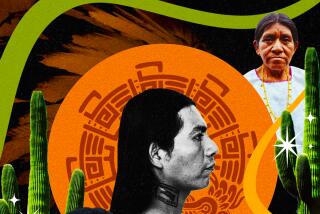Saving an Ancient Language
- Share via
TEL AVIV — Threatened with extinction, the everyday language of Jesus is now available on CD.
One of the few remaining groups of Aramaic speakers is using its music to preserve what in biblical times was the most widely spoken language in the Middle East.
In a small basement recording studio in Tel Aviv’s central bus terminal, the Nash Didan band lays down instrumental tracks for New Age-style songs written in Aramaic by their leader, Arik Mordechai.
Mordechai, a professional musician, said he began his mission to save Aramaic two years ago when his mother asked him to keep the language going. “The music is where the culture starts,” he said. “People can learn a little bit of a language that way.”
In biblical times, Aramaic was the lingua franca of the Middle East, while Hebrew was mostly used in sacred texts.
But today, the language is fading away.
Moshe Bar-Asher, president of the Academy of Hebrew Language in Jerusalem, said scholars expect the 3,000-year-old language to die out within two or three decades. About 500,000 to 800,000 people, mainly in the Middle East, still speak Aramaic, he said.
Mordechai and his parents belong to a 14,000-member group of Israeli Jews who call themselves Nash Didan--Aramaic for “our people.” They trace their roots back to northern Iran, around the town of Urmia.
*
The isolation of the mountainous area helped the Jews of Urmia preserve their religious heritage and the Aramaic language they had brought into exile from the Holy Land.
After Israel was founded in 1948, the Nash Didan began moving to the Jewish state. The tribe’s leader, Avraham Hachami, knew only Aramaic and Persian when he arrived as an 18-year-old.
Hachami sees the language of his forefathers waning. “The young people may know a few words, but they don’t speak it all the time. They speak Hebrew or English. Only the old people, me and my wife, we speak Aramaic all the time,” he said.
In Israel, the Nash Didan have preserved their Persian-style cooking and some of the old rituals, including a wedding ceremony in which the bride throws apples at her husband from the roof of their home.
Although Aramaic was primarily a secular language in ancient times, parts of the Bible’s books of Ezra and Daniel were written in the ancient tongue. In Jewish ritual, Aramaic is still the language of the Passover haggada--the story read at family Seders--and is also used in ceremonial readings for weddings and funerals.
Jesus’ last words on the cross are probably the most recognized Aramaic phrase. According to the Gospel of Matthew, Jesus cried, “Eloi, Eloi, lama sabachthani?”--”My God, my God, why have you forsaken me?”
Aramaic has been transformed over the centuries, borrowing from Arabic, and a modern speaker might have difficulty understanding the biblical language, said Joseph Naveh, professor of ancient languages at the Hebrew University of Jerusalem.
But the common roots are still apparent. Water is moyeh in Aramaic, mayim in Hebrew and miye in Arabic. Head is resha in Aramaic, rosh in Hebrew and ras in Arabic.
As spoken by Mordechai’s mother, Esther, who is in her 80s, Aramaic sounds quick and clipped, with a hard twang. She is listed as a “spiritual advisor” on the CDs’ liner notes and helps her son when he struggles for the right word in writing lyrics.
In the cramped studio, Esther Mordechai was surrounded by band members during a recent recording session, including lead singer Tali Amar, who comes from a different background but learned enough Aramaic to sing Mordechai’s songs.
Mordechai said the first two Aramaic CDs have sold several thousand copies each, not bad for a country with a population of only 6 million. A third album is in the works.
More to Read
Sign up for Essential California
The most important California stories and recommendations in your inbox every morning.
You may occasionally receive promotional content from the Los Angeles Times.













